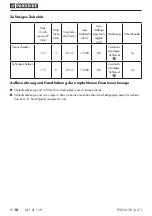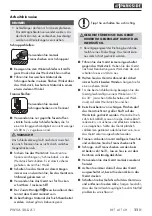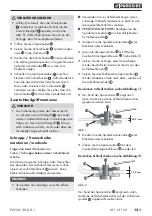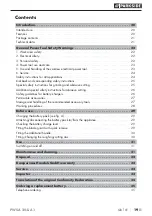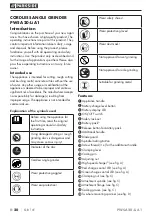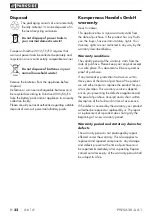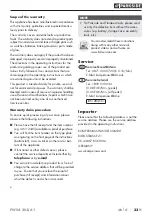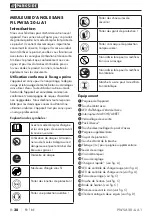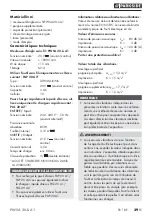
PWSA 20-Li A1
■
24
│
GB
│
IE
6. Service
a)
Have your power tool serviced by a qualified
repair person using only identical replace-
ment parts.
This will ensure that the safety of
the power tool is maintained.
Safety instructions for all applications
Special safety instructions for grinding and
abrasive cutting:
a)
This power tool is to be used as a grinder and
abrasive cutting appliance. Please follow all
safety instructions, instructions, diagrams and
data that you receive with the appliance.
If
you do not observe the following instructions,
this can lead to an electrical shock, fire and/or
serious injuries.
b)
This power tool is not suitable for sandpaper
sanding, working with a steel brush or bur-
nishing.
Using the power tool for applications
for which it is not designed can lead to hazards
and injuries.
c)
Do not use any accessories that have not
been specifically provided or recommended
by the manufacturer for this power tool.
Just
because you can attach the accessories to your
power tool, does not ensure they are safe to use.
d)
The maximum speed of the accessory tool
used must be at least as high as the maximum
speed specified for the power tool.
Accessories
that rotate faster than the permissible rate can
break and throw pieces into the air.
e)
The external diameter and thickness of the
accessory tool used must comply with the di-
mensions of the power tool.
Incorrectly dimen-
sioned accessory tools cannot be sufficiently
shielded or controlled.
f)
Attachment tools with a thread insert must
match the thread of the grinding spindle ex-
actly. For attachment tools that are mounted
using a flange, the diameter of the hole on
the attachment tool must correspond to the
width of the fitment on the flange.
Accessory
tools that cannot be firmly fitted to the power
tool rotate unevenly, vibrate severely and can
lead to a loss of control.
g)
Never use damaged accessory tools. Check
accessory tools such as grinding discs before
each use for chips or cracks, grinding plates
for cracks, wearing or excessive wear and
tear and wire brushes for loose or broken
wires. If the power tool or the accessory
tool in use is dropped, check to see if it is
damaged or use an undamaged accessory
tool. When you have checked and inserted
the accessory tool, ensure that you and any
other persons in the vicinity remain outside
the plane of the rotating accessory tool and
allow the tool to rotate at maximum speed
for one minute.
Damaged accessories usually
break during the test period.
h)
Wear personal protective equipment.
Depending on the application, ensure that
you use full face protection, eye protection
or goggles. Use a dust mask, hearing protec-
tion, protective gloves or special apron that
protect you from grindings and material par-
ticles as required.
Protect your eyes from flying
debris that may be created during certain ap-
plications. Dust or filter masks must be used to
filter any dust created by the application. If you
are exposed to loud noise for any length
of time, you may suffer hearing loss.
i)
Ensure that other people remain at a safe dis-
tance to your workspace. Anyone who enters
the workspace must wear personal protective
equipment.
Fragments of the workpiece or broken acces-
sory tools can fly off and cause injury – even
outside the immediate working area.
j)
Hold the power tool only by the insulated
handles when you are carrying out work
in which the accessory tool may come into
contact with concealed power cables.
Contact
with a live cable may also cause metal parts of
the appliance to become live and may result in
an electric shock.
k)
Keep the power cord away from any rotating
accessories.
If you lose control of the appli-
ance, the cord may get caught or cut and your
hand or arm could get caught in the rotating
accessory tool.

